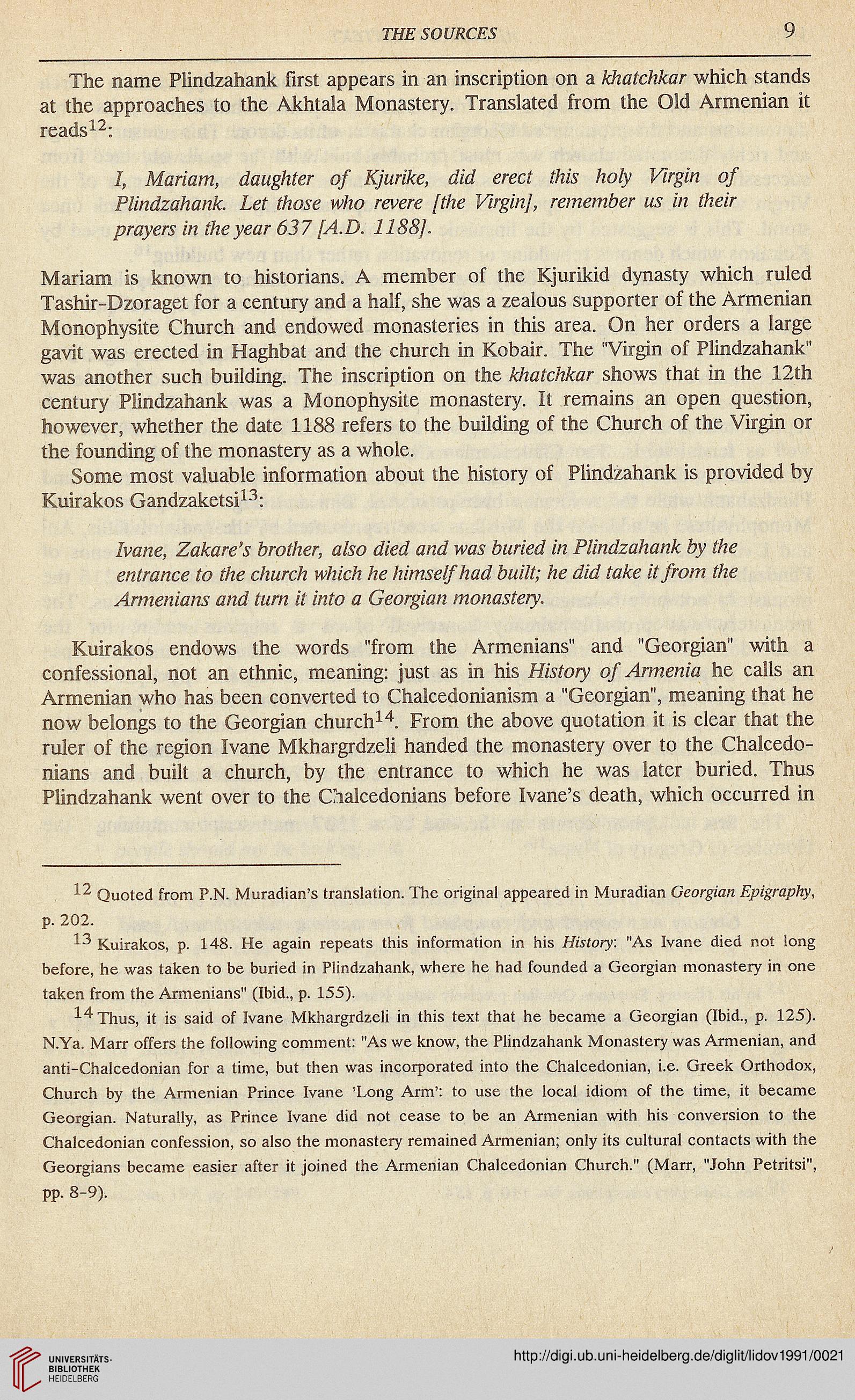7WE 50I/RCR5
9
The name Plindzahank first appears in an inscription on a k/zzzfc/zkzz/* which stands
at the approaches to the Akhtala Monastery. Translated from the Old Armenian it
reads^:
7, Mariam, JaagMer q/* K/zzrzkc, erect f/zzy /zo/p Fzz-gzzz o/'
Pfzzzzfzc/zzzzzk. Let bzoye w/zo revere /Z/zc kY/gz'zz/, re/ne/?z6er zzy a; Z/zezz
qrayen* in fire year 637 /A D. 7 / 33/.
Mariam is known to historians. A member of the Kjurikid dynasty which ruled
Tashir-Dzoraget for a century and a half, she was a zealous supporter of the Armenian
Monophysite Church and endowed monasteries in this area. On her orders a large
gavit was erected in Haghbat and the church in Kobair. The "Virgin of Plindzahank"
was another such building. The inscription on the k/zzzfc/zkzzz* shows that in the 12th
century Plindzahank was a Monophysite monastery. It remains an open question,
however, whether the date 1188 refers to the building of the Church of the Virgin or
the founding of the monastery as a whole.
Some most valuable information about the history of Plindzahank is provided by
Kuirakos Gandzakctsi^:
Dane, Zzzkzzre'y brof/zer, a/so zYz'ezY tzzzt? way bzzrzczf a? P/zzzb'zzzbzz/zk by Zbc
g/zZm/zce to Z/zc c/zzrrc/z w/zz'c/z /zc /zzzzzyc/f/zazf bzzz/Z,' /zc <Yz'<Y fake zY/fo/zz Z/ze
Amzezzzazzy a/zb Zzzrzz zY z'zzZo a Geozgzazz zzzozzayfe/y.
Kuirakos endows the words "from the Armenians" and "Georgian" with a
confessional, not an ethnic, meaning: just as in his Hzyfozy q/* Zrzzzezzz'a he calls an
Armenian who has been converted to Chalcedonianism a "Georgian", meaning that he
now belongs to the Georgian church^. From the above quotation it is clear that the
ruler of the region Ivane Mkhargrdzeli handed the monastery over to the Chalcedo-
nians and built a church, by the entrance to which he was later buried. Thus
Plindzahank went over to the Chalcedonians before 1 vane's death, which occurred in
12 Quoted from P.N. Muradian's translation. The originai appeared in Muradian Georgian TtpzgrapZty,
p. 202.
12 Kuirakos, p. 148. He again repeats this information in his HZrtory: "As Ivane died not iong
before, he was taken to be buried in Plindzahank, where he had founded a Georgian monastery in one
taken from the Armenians" (Ibid., p. 155).
14 Thus, it is said of Ivane Mkhargrdzeii in this text that he became a Georgian (Ibid., p. 125).
N.Ya. Marr offers the following comment: "As we know, the Plindzahank Monastery was Armenian, and
anti-Chalcedonian for a time, but then was incorporated into the Chalcedonian, i.e. Greek Orthodox,
Church by the Armenian Prince Ivane 'Long Arm': to use the local idiom of the time, it became
Georgian. Naturally, as Prince Ivane did not cease to be an Armenian with his conversion to the
Chalcedonian confession, so also the monastery remained Armenian; only its cultural contacts with the
Georgians became easier after it joined the Armenian Chalcedonian Church." (Marr, "John Petritsi",
pp. 8-9).
9
The name Plindzahank first appears in an inscription on a k/zzzfc/zkzz/* which stands
at the approaches to the Akhtala Monastery. Translated from the Old Armenian it
reads^:
7, Mariam, JaagMer q/* K/zzrzkc, erect f/zzy /zo/p Fzz-gzzz o/'
Pfzzzzfzc/zzzzzk. Let bzoye w/zo revere /Z/zc kY/gz'zz/, re/ne/?z6er zzy a; Z/zezz
qrayen* in fire year 637 /A D. 7 / 33/.
Mariam is known to historians. A member of the Kjurikid dynasty which ruled
Tashir-Dzoraget for a century and a half, she was a zealous supporter of the Armenian
Monophysite Church and endowed monasteries in this area. On her orders a large
gavit was erected in Haghbat and the church in Kobair. The "Virgin of Plindzahank"
was another such building. The inscription on the k/zzzfc/zkzzz* shows that in the 12th
century Plindzahank was a Monophysite monastery. It remains an open question,
however, whether the date 1188 refers to the building of the Church of the Virgin or
the founding of the monastery as a whole.
Some most valuable information about the history of Plindzahank is provided by
Kuirakos Gandzakctsi^:
Dane, Zzzkzzre'y brof/zer, a/so zYz'ezY tzzzt? way bzzrzczf a? P/zzzb'zzzbzz/zk by Zbc
g/zZm/zce to Z/zc c/zzrrc/z w/zz'c/z /zc /zzzzzyc/f/zazf bzzz/Z,' /zc <Yz'<Y fake zY/fo/zz Z/ze
Amzezzzazzy a/zb Zzzrzz zY z'zzZo a Geozgzazz zzzozzayfe/y.
Kuirakos endows the words "from the Armenians" and "Georgian" with a
confessional, not an ethnic, meaning: just as in his Hzyfozy q/* Zrzzzezzz'a he calls an
Armenian who has been converted to Chalcedonianism a "Georgian", meaning that he
now belongs to the Georgian church^. From the above quotation it is clear that the
ruler of the region Ivane Mkhargrdzeli handed the monastery over to the Chalcedo-
nians and built a church, by the entrance to which he was later buried. Thus
Plindzahank went over to the Chalcedonians before 1 vane's death, which occurred in
12 Quoted from P.N. Muradian's translation. The originai appeared in Muradian Georgian TtpzgrapZty,
p. 202.
12 Kuirakos, p. 148. He again repeats this information in his HZrtory: "As Ivane died not iong
before, he was taken to be buried in Plindzahank, where he had founded a Georgian monastery in one
taken from the Armenians" (Ibid., p. 155).
14 Thus, it is said of Ivane Mkhargrdzeii in this text that he became a Georgian (Ibid., p. 125).
N.Ya. Marr offers the following comment: "As we know, the Plindzahank Monastery was Armenian, and
anti-Chalcedonian for a time, but then was incorporated into the Chalcedonian, i.e. Greek Orthodox,
Church by the Armenian Prince Ivane 'Long Arm': to use the local idiom of the time, it became
Georgian. Naturally, as Prince Ivane did not cease to be an Armenian with his conversion to the
Chalcedonian confession, so also the monastery remained Armenian; only its cultural contacts with the
Georgians became easier after it joined the Armenian Chalcedonian Church." (Marr, "John Petritsi",
pp. 8-9).




